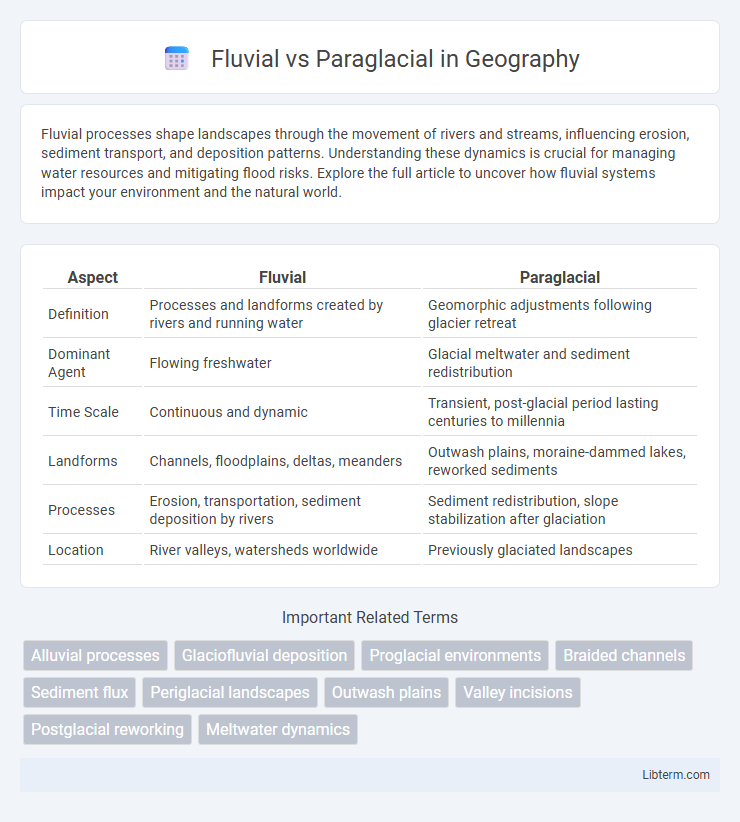Fluvial processes shape landscapes through the movement of rivers and streams, influencing erosion, sediment transport, and deposition patterns. Understanding these dynamics is crucial for managing water resources and mitigating flood risks. Explore the full article to uncover how fluvial systems impact your environment and the natural world.
Table of Comparison
| Aspect | Fluvial | Paraglacial |
|---|---|---|
| Definition | Processes and landforms created by rivers and running water | Geomorphic adjustments following glacier retreat |
| Dominant Agent | Flowing freshwater | Glacial meltwater and sediment redistribution |
| Time Scale | Continuous and dynamic | Transient, post-glacial period lasting centuries to millennia |
| Landforms | Channels, floodplains, deltas, meanders | Outwash plains, moraine-dammed lakes, reworked sediments |
| Processes | Erosion, transportation, sediment deposition by rivers | Sediment redistribution, slope stabilization after glaciation |
| Location | River valleys, watersheds worldwide | Previously glaciated landscapes |
Introduction to Fluvial and Paraglacial Processes
Fluvial processes involve the movement and shaping of landscapes through the action of running water in rivers and streams, primarily driven by erosion, transportation, and deposition of sediments. Paraglacial processes occur in landscapes recently exposed by glacier retreat, where sediment destabilization, slope adjustments, and reworking of glacial deposits dominate sediment dynamics. Understanding these processes is essential for analyzing landscape evolution in post-glacial environments and active river systems.
Defining Fluvial Systems
Fluvial systems are defined by the processes and landforms created by rivers and streams, characterized by the continuous movement of water shaping channels, floodplains, and deltas through erosion, sediment transport, and deposition. These systems play a critical role in landscape evolution by regulating sediment distribution and influencing ecosystem dynamics. Understanding fluvial dynamics is essential for managing water resources, predicting flood risks, and assessing environmental changes in riverine environments.
Understanding Paraglacial Environments
Paraglacial environments are defined by the landscape adjustments following glacial retreat, characterized by destabilized slopes, sediment-rich river systems, and rapid geomorphological changes. Fluvial processes in these settings are heavily influenced by the availability of glacial meltwater, leading to dynamic sediment transport and deposition patterns distinct from typical river systems. Understanding paraglacial environments requires analyzing the interplay between retreating ice masses and subsequent fluvial activity shaping valley floors and sedimentary deposits.
Key Differences Between Fluvial and Paraglacial Dynamics
Fluvial dynamics are primarily driven by the movement of water in rivers and streams, shaping landscapes through processes like erosion, transport, and deposition of sediments. Paraglacial dynamics occur in landscapes recently freed from glacial ice, characterized by sediment reworking and instability due to the adjustment of previously glaciated terrain to new climatic and hydrological conditions. Key differences include the dominant driving forces--fluvial relies on continuous water flow, while paraglacial involves episodic sediment mobilization during deglaciation--and the temporal scale, with fluvial processes operating steadily over long periods and paraglacial processes occurring more abruptly during post-glacial transitions.
Sediment Transport in Fluvial Versus Paraglacial Settings
Sediment transport in fluvial settings primarily occurs through continuous water flow, moving particles by processes like bed load and suspended load transport, shaped by river discharge and channel morphology. In paraglacial environments, sediment transport is episodic and influenced by glacial retreat, where meltwater streams and mass wasting redistribute unconsolidated glacial deposits. The key distinction lies in fluvial transport's sustained hydrodynamic activity versus paraglacial settings' variable sediment release linked to deglaciation and climatic fluctuations.
Landform Development: Fluvial Versus Paraglacial Influences
Fluvial landform development is primarily driven by the action of flowing water, shaping river valleys, floodplains, and alluvial fans through sediment transport and erosion. Paraglacial processes influence landforms in recently deglaciated environments, where sediment redistribution occurs due to meltwater runoff, slope instability, and enhanced erosion linked to glacial retreat. The distinction lies in fluvial systems' sustained channelized flow versus paraglacial systems' transient, landscape-adjusting responses to deglaciation and sediment availability.
Climate Impact on Fluvial and Paraglacial Activity
Fluvial processes are heavily influenced by climate through variations in precipitation and temperature, which alter river discharge, sediment transport, and erosion rates. Paraglacial activity responds to climatic shifts by triggering sediment redistribution and landscape adjustments following glacial retreat, driven primarily by temperature increases and melting rates. Both fluvial and paraglacial environments exhibit dynamic responses to climate variability, significantly impacting geomorphological evolution.
Human Impacts on Fluvial and Paraglacial Landscapes
Human impacts on fluvial landscapes include river damming, channelization, and sediment extraction, which alter natural flow regimes and disrupt aquatic ecosystems. Paraglacial landscapes face disturbances from activities such as mining, deforestation, and infrastructure development, accelerating erosion and destabilizing permafrost. Both environments experience reduced biodiversity and increased vulnerability to climate change due to anthropogenic alterations.
Case Studies: Fluvial and Paraglacial Features Worldwide
Fluvial case studies highlight dynamic river processes shaping landscapes through erosion, sediment transport, and deposition, evident in meandering rivers such as the Mississippi and braided channels of the Brahmaputra. Paraglacial case studies emphasize landscapes influenced by glacial retreat, including outwash plains and reworked moraines found in regions like the European Alps and Alaska's Copper River basin. Comparing these features worldwide reveals that fluvial systems actively reshape terrains during stable climatic conditions, while paraglacial environments represent transitional landscapes undergoing rapid adjustment following glacial melting.
Conclusion: Comparing Fluvial and Paraglacial Processes
Fluvial processes primarily shape landscapes through the continuous action of flowing water, leading to erosion, sediment transport, and deposition within river systems. Paraglacial processes occur in post-glacial environments, driven by the adjustment of landscapes to deglaciation, involving mass wasting, sediment redistribution, and stabilization influenced by melting ice. Comparing these, fluvial processes dominate in shaping dynamic river channels and floodplains, whereas paraglacial processes significantly modify terrain immediately following glacial retreat, often setting the stage for subsequent fluvial activity.
Fluvial Infographic

 libterm.com
libterm.com